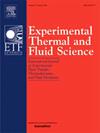倾斜射流冲击液膜冷却与热回流的实验研究
IF 3.3
2区 工程技术
Q2 ENGINEERING, MECHANICAL
Experimental Thermal and Fluid Science
Pub Date : 2025-08-21
DOI:10.1016/j.expthermflusci.2025.111600
引用次数: 0
摘要
液膜冷却在保护液体火箭发动机燃烧室免受极端热环境影响方面起着至关重要的作用。然而,热吸回效应仍然是发动机过热的主要原因。实验研究了液膜冷却和热回流过程中的传热特性。利用高速摄像机对液膜流动进行可视化。考虑了液体温度、壁面过热度和输入功率的影响。结果表明:壁面过热度对润湿锋扩展的影响最大,其次是液体温度和输入功率;沸腾的阻碍作用使润湿锋速度减慢。热分析表明,液膜冷却和热回流过程中的表面热流密度与壁面过热度和输入功率呈正相关,与液体温度成反比。此外,与液膜下游相比,在撞击点处,由热回吸效应引起的壁面温升更为严重。长时间的冷却时间放大了这种差异,撞击点温度不断上升,而液膜下游则持续冷却。这是由于倾斜射流撞击和加热器提供的壁面热流的综合作用造成的。冷却性能的定量评价包括总散热和冷却效率。通过液膜飞溅率计算的冷却效率表明了液膜流动与传热的耦合效应。本文章由计算机程序翻译,如有差异,请以英文原文为准。
Experimental investigation of cooling and heat soak-back in inclined jet impingement liquid film
Liquid film cooling plays a critical role in protecting the combustion chambers of liquid rocket engines from extreme thermal conditions. However, the heat soak-back effect remains a primary cause of engine overheating. This paper experimentally investigates the heat transfer characteristics during liquid film cooling and heat soak-back. The liquid film flow is visualized using a high-speed camera. The effects of liquid temperature, wall superheat, and input power are considered. The results indicate that the wall superheat exerts the strongest effect on the propagation of the wetting front, followed by liquid temperature and input power. The hindering effect of boiling decelerates the wetting front velocity. Thermal analysis reveals that the surface heat flux during liquid film cooling and heat soak-back exhibits a positive correlation with wall superheat and input power while being inversely proportional to liquid temperature. In addition, compared to the downstream of the liquid film, the wall temperature rise caused by the heat soak-back effect is more severe at the impingement point. Prolonged cooling durations amplify this divergence, with impingement point temperatures rising continuously while downstream of the liquid film exhibits sustained cooling. This is attributed to the combined effects of oblique jet impinging and the wall heat flux provided by the heater. The quantitative evaluation of cooling performance incorporates both the total heat removal and cooling efficiency. The cooling efficiency calculated through liquid film splashing rate demonstrates the coupling effect of liquid film flow and heat transfer.
求助全文
通过发布文献求助,成功后即可免费获取论文全文。
去求助
来源期刊

Experimental Thermal and Fluid Science
工程技术-工程:机械
CiteScore
6.70
自引率
3.10%
发文量
159
审稿时长
34 days
期刊介绍:
Experimental Thermal and Fluid Science provides a forum for research emphasizing experimental work that enhances fundamental understanding of heat transfer, thermodynamics, and fluid mechanics. In addition to the principal areas of research, the journal covers research results in related fields, including combined heat and mass transfer, flows with phase transition, micro- and nano-scale systems, multiphase flow, combustion, radiative transfer, porous media, cryogenics, turbulence, and novel experimental techniques.
 求助内容:
求助内容: 应助结果提醒方式:
应助结果提醒方式:


